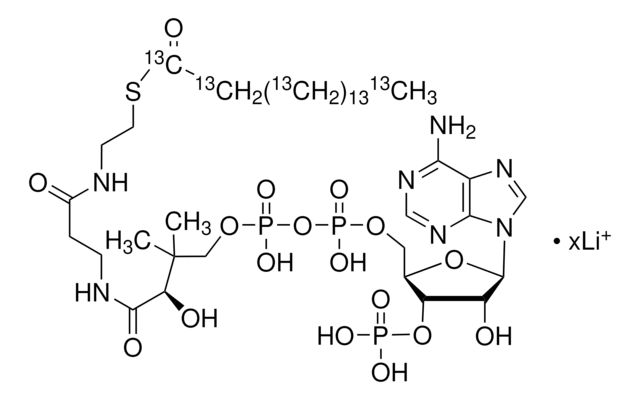870716P
Avanti
16:0 Coenzyme A
Avanti Research™ - A Croda Brand 870716P, powder
Sinónimos:
palmitoyl Coenzyme A (ammonium salt)
About This Item
Productos recomendados
form
powder
packaging
pkg of 1 × 10 mg (870716P-10mg)
pkg of 1 × 25 mg (870716P-25mg)
pkg of 1 × 5 mg (870716P-5mg)
manufacturer/tradename
Avanti Research™ - A Croda Brand 870716P
application(s)
lipidomics
lipid type
coenzymes
shipped in
dry ice
storage temp.
−20°C
SMILES string
O[C@@](C(NCCC(NCCSC(CCCCCCCCCCCCCCC)=O)=O)=O)(C(C)(COP([O-])(OP([O-])(OC[C@H]([C@H]1OP([O-])(O)=O)O[C@H]([C@@H]1O)N2C3=C(C(N)=NC=N3)N=C2)=O)=O)C)[H].[NH4+].[NH4+].[NH4+]
InChI
1S/C37H66N7O17P3S.3H3N/c1-4-5-6-7-8-9-10-11-12-13-14-15-16-17-28(46)65-21-20-39-27(45)18-19-40-35(49)32(48)37(2,3)23-58-64(55,56)61-63(53,54)57-22-26-31(60-62(50,51)52)30(47)36(59-26)44-25-43-29-33(38)41-24-42-34(29)44;;;/h24-26,30-32,36,47-48H,4-23H2,1-3H3,(H,39,45)(H,40,49)(H,53,54)(H,55,56)(H2,38,41,42)(H2,50,51,52);3*1H3/t26-,30?,31+,32+,36-;;;/m1.../s1
InChI key
VJXJWGKNGIGUQX-AUCFWDBISA-N
General description
Application
- standard in mass spectrometry for qualitative analysis of palmitoyl acyl-CoA in mycobacterium cells
- constituent of the binding buffer in protein in vitro binding assay
- substrate in serine palmitoyltransferase assay
Packaging
Legal Information
Storage Class
11 - Combustible Solids
Elija entre una de las versiones más recientes:
Certificados de análisis (COA)
It looks like we've run into a problem, but you can still download Certificates of Analysis from our Documentos section.
Si necesita más asistencia, póngase en contacto con Atención al cliente
¿Ya tiene este producto?
Encuentre la documentación para los productos que ha comprado recientemente en la Biblioteca de documentos.
Los clientes también vieron
Nuestro equipo de científicos tiene experiencia en todas las áreas de investigación: Ciencias de la vida, Ciencia de los materiales, Síntesis química, Cromatografía, Analítica y muchas otras.
Póngase en contacto con el Servicio técnico















